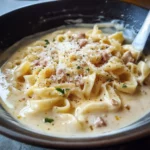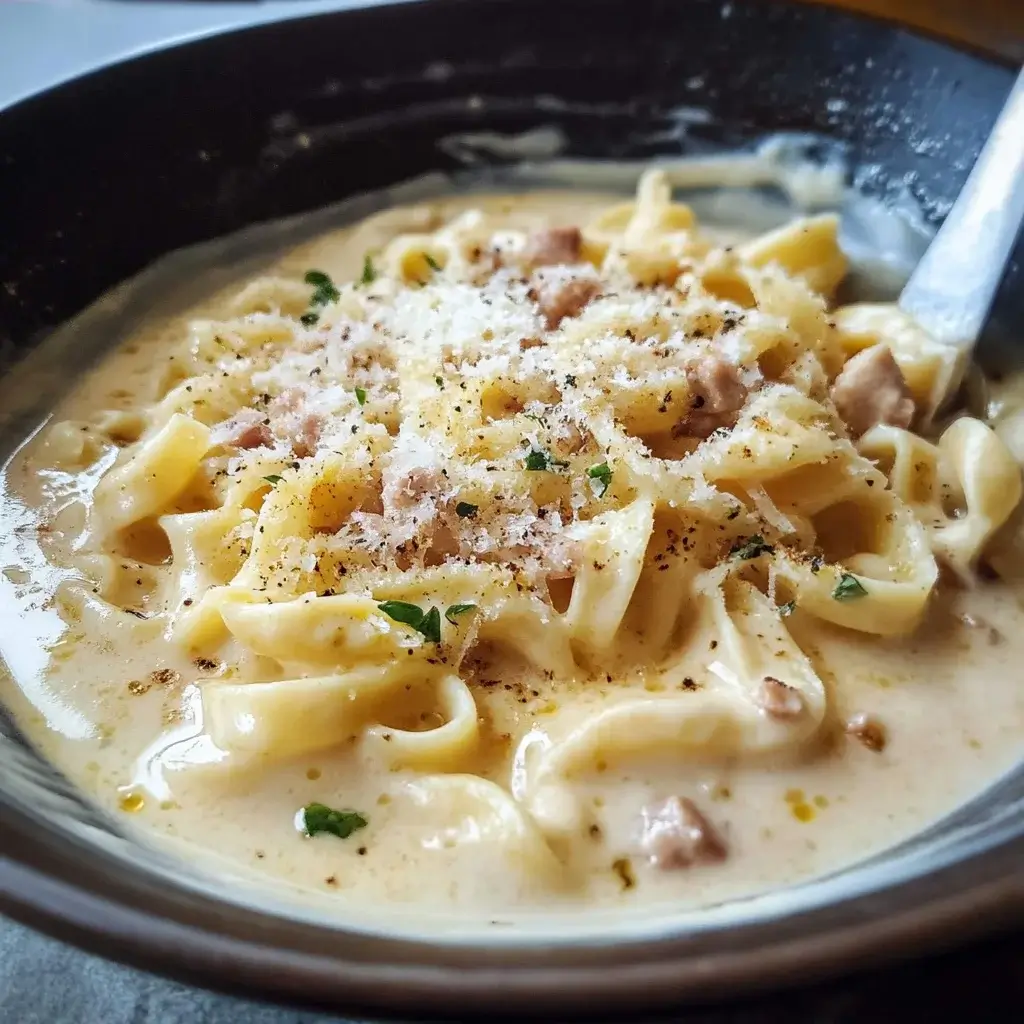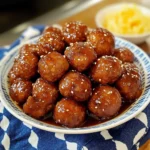Let me tell you a secret: I used to be intimidated by carbonara. The whispers of raw eggs and the pursuit of perfectly rendered guanciale felt like culinary tightropes I wasn’t quite ready to walk. Then, I stumbled upon Crème Fraîche Carbonara, and everything changed. This isn’t your traditional, strictly purist carbonara, but it’s a revelation in its own right. The addition of crème fraîche elevates the sauce to a level of unparalleled creaminess and richness, while still retaining the essential flavors of the original. The result is a dish that’s both comforting and sophisticated, intensely flavorful yet surprisingly easy to master. My family, who are self-proclaimed pasta aficionados, now request this version over and over again. It’s become my go-to for a weeknight indulgence that feels special, or when I want to impress guests without spending hours in the kitchen. If you’re looking for a carbonara that’s luxuriously creamy, deeply flavorful, and approachable for home cooks, prepare to fall in love with Crème Fraîche Carbonara. It’s a delightful deviation that might just become your new favorite.
Ingredients: The Foundation of Flavor and Creaminess
The beauty of Crème Fraîche Carbonara lies in its simplicity. It relies on a few key, high-quality ingredients to create a dish that is far greater than the sum of its parts. Let’s break down each ingredient and understand its crucial role in achieving that perfect creamy, flavorful carbonara.
For the Pasta:
- 1 pound Spaghetti or Bucatini: Traditionally, spaghetti or bucatini (a thicker, spaghetti-like pasta with a hole running through the center) are used for carbonara. Their long strands perfectly capture the creamy sauce. High-quality bronze-die pasta is recommended for its rougher texture, which helps the sauce cling beautifully. You can also use other long pasta shapes like linguine or fettuccine if preferred.
- Salt for Pasta Water: Generous seasoning of the pasta water is crucial for flavorful pasta. Use about 1-2 tablespoons of kosher salt per gallon of water.
For the Creamy Carbonara Sauce:
- 4 large Egg Yolks: Egg yolks are the heart of carbonara, providing richness, emulsification, and that signature creamy texture. Use fresh, high-quality eggs. Some recipes use whole eggs or a combination of whole eggs and yolks; this recipe focuses on yolks for maximum richness.
- 1 cup Crème Fraîche: This is the star ingredient that sets this carbonara apart. Crème fraîche, a slightly tangy and rich cultured cream, adds an unparalleled level of creaminess and stability to the sauce, making it less prone to curdling than traditional carbonara sauces relying solely on eggs. Full-fat crème fraîche is recommended for the best flavor and texture.
- 1 cup Pecorino Romano Cheese, finely grated: Pecorino Romano is a hard, salty Italian cheese made from sheep’s milk. It provides the signature salty, sharp, and savory flavor that is essential to authentic carbonara. Finely grating it ensures it melts smoothly into the sauce. Do not substitute with Parmesan cheese in this recipe, as Pecorino Romano’s distinct flavor is key to carbonara’s character.
- Freshly Ground Black Pepper: Generous amounts of freshly ground black pepper are vital to carbonara. It adds a pungent spice that cuts through the richness of the sauce and complements the other flavors. Use freshly cracked black pepper for the best aroma and taste.
For the Guanciale (or Pancetta/Bacon):
- 4 ounces Guanciale, cut into ¼-inch thick lardons: Guanciale, cured pork jowl, is the traditional and most authentic choice for carbonara. It renders beautifully, releasing flavorful fat and becoming crispy. Its unique porky flavor is distinct from bacon or pancetta. Cut it into lardons (small batons or cubes) for even cooking.
- Alternatively, 4 ounces Pancetta, cut into ¼-inch thick lardons: Pancetta, Italian cured pork belly, is a more readily available and acceptable substitute for guanciale. It offers a similar richness and flavor profile, though slightly less intense than guanciale.
- Or, as a last resort, 4 ounces Thick-Cut Bacon, cut into ¼-inch thick lardons: While not traditional, thick-cut bacon can be used in a pinch. Choose a good quality, thick-cut bacon for the best flavor and texture. Be aware that bacon will impart a smokier flavor than guanciale or pancetta.
Optional Garnishes:
- Extra Pecorino Romano Cheese, grated: For serving, to sprinkle over the finished pasta.
- Fresh Parsley, chopped: For a touch of freshness and color.
- Extra Egg Yolks: For an even richer presentation (serve with caution due to raw yolks).
Ingredient Notes and Substitutions:
- Cheese Substitutions (Not Recommended for Authentic Flavor): While Pecorino Romano is essential for authentic carbonara flavor, in a pinch, you could use a very aged, sharp Parmesan cheese, but the flavor profile will be noticeably different. Avoid using pre-grated cheese as it often contains cellulose and doesn’t melt as smoothly.
- Crème Fraîche Substitutions (Use with Caution): While crème fraîche is key to this recipe’s creamy texture and stability, you could try substituting with full-fat sour cream or mascarpone cheese, but the tanginess and richness will be slightly different. Greek yogurt is not recommended as it is too tangy and less rich.
- Meat Substitutions (Flavor Variations): While guanciale is traditional, pancetta is a widely accepted and delicious substitute. Bacon, while not traditional, can work if you are unable to find guanciale or pancetta. Avoid using leaner meats or sausage as they lack the rendered fat crucial for the sauce.
- Pasta Variations: While spaghetti and bucatini are classic, you can experiment with other long pasta shapes like linguine, fettuccine, or even short pasta shapes like rigatoni or penne, though the sauce may cling better to long strands.
Instructions: Mastering the Art of Creamy Carbonara
Making Crème Fraîche Carbonara is surprisingly quick and straightforward once you understand the technique. The key is to work efficiently and ensure the heat from the pasta water cooks the egg yolks and crème fraîche gently, creating a luscious, creamy sauce without scrambling the eggs.
Step 1: Prepare the Guanciale (or Pancetta/Bacon)
- Render the fat: In a large skillet (preferably cast iron or stainless steel), place the guanciale lardons over medium heat. Cook slowly, stirring occasionally, until the fat renders and the guanciale becomes crispy and golden brown. This will take about 8-10 minutes.
- Reserve rendered fat: Once crispy, remove the guanciale from the skillet with a slotted spoon and set aside, keeping it warm. Crucially, reserve the rendered guanciale fat in the skillet. This flavorful fat is essential for the sauce.
Step 2: Cook the Pasta
- Boil pasta water: While the guanciale is rendering, bring a large pot of salted water to a rolling boil. Use plenty of water to allow the pasta to cook properly (at least 4 quarts).
- Cook pasta al dente: Add the spaghetti or bucatini to the boiling water and cook according to package directions for “al dente.” “Al dente” means “to the tooth” – the pasta should be firm to the bite, with a slight resistance in the center. This is important because the pasta will continue to cook slightly in the sauce. Reserve about 1 cup of pasta water before draining.
Step 3: Prepare the Crème Fraîche Egg Sauce
- Whisk egg yolks and cheese: While the pasta is cooking, in a large bowl (large enough to hold the cooked pasta later), whisk together the egg yolks, crème fraîche, and grated Pecorino Romano cheese until well combined and smooth.
- Season with pepper: Generously season the egg mixture with freshly ground black pepper. Don’t be shy with the pepper – it’s a key flavor component of carbonara. You can add a pinch of salt if desired, but the Pecorino Romano is already quite salty, so taste before adding salt.
Step 4: Assemble the Carbonara
- Drain pasta and add to fat: Once the pasta is cooked al dente, quickly drain it, but do not rinse it. Immediately add the hot, drained pasta to the skillet with the reserved rendered guanciale fat. Toss the pasta in the fat to coat it evenly.
- Remove from heat (Important!): Crucially, remove the skillet from the heat. This is vital to prevent the eggs in the sauce from scrambling.
- Pour in egg sauce: Immediately pour the crème fraîche egg and cheese mixture over the hot pasta in the skillet.
- Toss vigorously: Quickly and vigorously toss the pasta and sauce together using tongs or two forks. The heat from the pasta and skillet will gently cook the egg yolks and crème fraîche, creating a creamy sauce that coats the pasta. Continue tossing until the sauce thickens and becomes glossy, clinging to the pasta strands. If the sauce seems too thick, add a tablespoon or two of the reserved hot pasta water at a time, tossing continuously, until you reach your desired creamy consistency. You may not need to use all the reserved pasta water.
- Add crispy guanciale: Stir in most of the crispy guanciale, reserving some for garnish.
- Taste and adjust seasoning: Taste the carbonara and adjust seasoning as needed. You may want to add more black pepper or a touch of salt, if necessary. Remember that the flavors will continue to develop as it sits.
Step 5: Serve Immediately
- Serve hot: Serve Crème Fraîche Carbonara immediately while it’s hot and creamy. Carbonara is best enjoyed fresh as the sauce can thicken and become less creamy as it cools.
- Garnish: Divide the carbonara among warm serving bowls. Garnish with the reserved crispy guanciale, extra grated Pecorino Romano cheese, and chopped fresh parsley, if desired. You can also offer freshly ground black pepper at the table for guests to add more to their liking.
Tips for Perfect Crème Fraîche Carbonara:
- Work quickly: Once the pasta is cooked, work quickly to assemble the carbonara. The heat from the pasta is essential for cooking the sauce properly.
- Remove from heat before adding sauce: Always remove the skillet from the heat before adding the egg and crème fraîche mixture to prevent scrambling.
- Use hot pasta water to adjust consistency: Reserved hot pasta water is your secret weapon for achieving the perfect creamy sauce consistency. Add it gradually, tossing continuously, until you reach the desired creaminess.
- Don’t overcook the pasta: Cook the pasta al dente, as it will continue to cook slightly in the sauce. Overcooked pasta will become mushy.
- Freshly grate the cheese: Use freshly grated Pecorino Romano cheese for the best flavor and melting quality. Pre-grated cheese often contains anti-caking agents that can hinder smooth melting.
Nutrition Facts: Indulgent Yet Satisfying
Crème Fraîche Carbonara is undeniably a rich and indulgent dish, but it can be enjoyed as part of a balanced diet in moderation. Here’s an approximate nutritional breakdown per serving.
Servings: 4-6 servings
Approximate Nutrition Facts per Serving (based on 5 servings):
- Calories: Approximately 650-800 calories (depending on portion size and ingredients)
- Protein: 30-35 grams
- Fat: 45-60 grams (primarily from egg yolks, crème fraîche, guanciale, and cheese)
- Saturated Fat: 25-35 grams
- Cholesterol: 250-350 mg
- Sodium: 800-1200 mg (can vary depending on cheese and cured pork)
- Carbohydrates: 50-60 grams
- Fiber: 3-4 grams
- Sugar: 2-3 grams (naturally occurring sugars in milk)
Key Nutritional Considerations:
- High in Calories and Fat: Carbonara is a calorie-dense and high-fat dish due to the rich ingredients. Enjoy in moderation as part of a balanced diet.
- Good Source of Protein: Eggs, cheese, and guanciale provide a significant amount of protein, essential for muscle building and satiety.
- Sodium Content: Pecorino Romano cheese and cured pork like guanciale are naturally high in sodium. Be mindful of sodium intake, especially if you are watching your sodium levels.
- Cholesterol Content: Egg yolks are high in cholesterol. If you are concerned about cholesterol intake, consult with a healthcare professional.
- Calcium: Cheese and crème fraîche are good sources of calcium, important for bone health.
Tips for Making it Slightly Lighter (Subtle Changes):
- Use 2% milk crème fraîche: While full-fat crème fraîche is recommended for the richest flavor, using a 2% milk crème fraîche can slightly reduce the fat content.
- Reduce guanciale portion slightly: While guanciale is key, you can slightly reduce the amount without drastically affecting the flavor profile.
- Serve smaller portions: Portion control is key to managing calorie intake. Enjoy a smaller serving size as part of a balanced meal.
- Pair with a large salad: Serve with a large side salad with a light vinaigrette to add fiber and nutrients to your meal and balance out the richness of the carbonara.
Please note: Nutritional information is an estimate and may vary depending on specific ingredients, brands, and portion sizes. For precise nutritional information, you can use online nutrition calculators with the specific brands and quantities of ingredients you use.
Preparation Time: Quick and Impressive
Crème Fraîche Carbonara is surprisingly quick to prepare, making it an excellent choice for a satisfying weeknight meal or an impressive dish for guests.
- Prep Time: 15-20 minutes (includes cutting guanciale, grating cheese, and preparing sauce ingredients)
- Cook Time: 20-25 minutes (includes rendering guanciale, cooking pasta, and assembling sauce)
- Total Time: Approximately 35-45 minutes
Make-Ahead Tips:
- Grate cheese in advance: You can grate the Pecorino Romano cheese ahead of time and store it in an airtight container in the refrigerator.
- Cut guanciale in advance: You can cut the guanciale into lardons ahead of time and store it in the refrigerator.
- Prepare egg and crème fraîche mixture (not recommended): While you could whisk together the egg yolks, crème fraîche, and cheese mixture ahead of time, it’s best to prepare it just before cooking to maintain the freshest texture. If you must, prepare it no more than 30 minutes in advance and keep it refrigerated.
Time-Saving Tip:
- Efficient multitasking: While the guanciale is rendering, get the pasta water boiling and prepare the egg and crème fraîche mixture. This efficient multitasking will help you get dinner on the table quickly.
How to Serve: Elegant and Versatile
Crème Fraîche Carbonara is a versatile dish that can be served in various ways, from casual weeknight dinners to more formal occasions.
Serving Occasions:
- Weeknight Indulgence: A quick yet satisfying and decadent meal for a weeknight treat.
- Impressive Dinner Party Dish: Elegant and flavorful enough to impress guests at a dinner party.
- Romantic Dinner for Two: A classic and romantic pasta dish perfect for a special occasion.
- Comfort Food Craving: Hits the spot when you’re craving rich and creamy comfort food.
- Italian-Themed Meal: A perfect centerpiece for an Italian-themed dinner.
Serving Suggestions and Pairings:
- Serve as a Main Course: Crème Fraîche Carbonara is typically served as a main course. A generous portion is satisfying on its own.
- Starter Course (Smaller Portions): You can serve smaller portions as a starter course before a lighter main dish, such as grilled fish or chicken.
- Side Salad: Always pair carbonara with a fresh green salad dressed with a light vinaigrette to balance the richness and add freshness. A simple arugula salad or a mixed green salad with lemon vinaigrette works beautifully.
- Garlic Bread or Crusty Bread: Serve with garlic bread or crusty Italian bread for soaking up any leftover creamy sauce.
- White Wine Pairing: Pair with a crisp, dry white wine like Pinot Grigio, Vermentino, or a light-bodied Chardonnay to complement the richness of the carbonara.
- Italian Red Wine (Light-Bodied): For red wine lovers, a light-bodied Italian red like Chianti or Sangiovese can also pair well.
Garnish Ideas:
- Extra Grated Pecorino Romano: Always offer extra grated Pecorino Romano cheese at the table for guests to add to their liking.
- Fresh Parsley, Chopped: A sprinkle of chopped fresh parsley adds a pop of color and freshness.
- Freshly Ground Black Pepper: Offer freshly ground black pepper at the table so guests can add more to their taste.
- Red Pepper Flakes (Optional): For those who like a touch of heat, a pinch of red pepper flakes can be sprinkled over the top.
- Crispy Guanciale Crumbles: Reserve extra crispy guanciale crumbles to garnish each serving for added texture and flavor.
- Egg Yolk (Optional, for Presentation and Richness – Serve with Caution): For a visually stunning and extra-rich presentation, you can carefully place a raw egg yolk in the center of each serving just before serving. Inform guests that the yolk is raw and should be stirred into the pasta for added richness. Serve with caution due to the use of raw egg yolks.
Additional Tips: Elevating Your Crème Fraîche Carbonara
Here are five additional tips to ensure your Crème Fraîche Carbonara is truly exceptional:
- Use High-Quality Ingredients: Since this recipe has so few ingredients, the quality of each one shines through. Use good quality pasta, fresh eggs, authentic Pecorino Romano cheese, and high-quality guanciale or pancetta for the best flavor.
- Warm Your Serving Bowls: Warming your serving bowls before plating the carbonara helps to keep the pasta hot and the sauce creamy for longer. You can warm bowls by rinsing them with hot water and drying them, or by briefly warming them in a low oven.
- Don’t Overcrowd the Skillet: If making a large batch, cook the guanciale in batches to avoid overcrowding the skillet. Overcrowding can cause the guanciale to steam instead of crisping properly.
- Adjust Crème Fraîche Amount to Preference: While 1 cup of crème fraîche provides a wonderfully creamy sauce, you can adjust the amount to your preference. For a slightly lighter sauce, start with ¾ cup and add more as needed. For an even richer sauce, you can increase it slightly, but be mindful not to overpower the other flavors.
- Experiment with Finishing Oils: For an extra layer of flavor and richness, consider drizzling a high-quality finishing oil over the carbonara just before serving. Truffle oil (used sparingly), chili oil, or a good quality extra virgin olive oil can add a lovely finishing touch.
FAQ: Your Crème Fraîche Carbonara Questions Answered
Here are five frequently asked questions about making Crème Fraîche Carbonara:
Q1: Can I make Crème Fraîche Carbonara vegetarian?
A: Traditional carbonara is not vegetarian due to the inclusion of pork (guanciale, pancetta, or bacon). To make a vegetarian version, you would need to omit the pork entirely. You could try adding sautéed mushrooms or roasted vegetables like asparagus or zucchini to add some substance and flavor to the dish. However, it will no longer be considered carbonara in the traditional sense.
Q2: Can I use Parmesan cheese instead of Pecorino Romano?
A: While Parmesan cheese is a delicious Italian cheese, Pecorino Romano is the traditional and recommended cheese for carbonara. Pecorino Romano has a sharper, saltier, and more assertive flavor than Parmesan, which is crucial to the characteristic taste of carbonara. Substituting with Parmesan will result in a milder and less authentic flavor profile. If you absolutely cannot find Pecorino Romano, you can use a very aged, sharp Parmesan cheese as a last resort, but the flavor will be different.
Q3: Is it safe to eat raw egg yolks in carbonara?
A: Traditional carbonara sauce relies on the heat from the hot pasta and rendered guanciale fat to gently cook the raw egg yolks, creating a creamy sauce. While this method is generally considered safe, there is always a slight risk associated with consuming raw or undercooked eggs, particularly for individuals with weakened immune systems, young children, and the elderly. Using fresh, high-quality eggs from a reputable source and ensuring the pasta and skillet are hot when assembling the sauce helps to mitigate the risk. If you are concerned about raw eggs, you can use pasteurized eggs, although they may slightly alter the texture of the sauce.
Q4: My carbonara sauce is too thick or too dry. How can I fix it?
A: If your carbonara sauce is too thick or dry, it likely means it absorbed too much of the pasta water or cooked for too long and became too dense. To fix it, gradually add a tablespoon or two of reserved hot pasta water at a time, tossing continuously, until you reach your desired creamy consistency. The hot pasta water will help to loosen the sauce and create a smoother, more emulsified texture. Avoid adding milk or cream as they will dilute the flavor and texture in an undesirable way.
Q5: Can I make Crème Fraîche Carbonara ahead of time?
A: Carbonara is best enjoyed fresh and immediately after it is made. It is not recommended to make it fully ahead of time as the sauce can thicken and become less creamy as it cools and sits. The pasta can also become overcooked and mushy upon reheating. However, you can prepare some components ahead of time to speed up the process on the day you plan to serve it. You can grate the cheese, cut the guanciale, and have the crème fraîche and eggs ready in advance. Cook the pasta and assemble the carbonara sauce just before serving for the best quality and texture. If you have leftovers, they can be stored in the refrigerator for up to a day, but the texture will not be as creamy upon reheating. Reheat gently with a splash of milk or pasta water to try and restore some of the creaminess.
Enjoy creating and savoring this decadent and creamy Crème Fraîche Carbonara! It’s a delightful twist on a classic that is sure to impress.
Print
Crème Fraîche Carbonara recipe
Ingredients
For the Pasta:
-
- 1 pound Spaghetti or Bucatini: Traditionally, spaghetti or bucatini (a thicker, spaghetti-like pasta with a hole running through the center) are used for carbonara. Their long strands perfectly capture the creamy sauce. High-quality bronze-die pasta is recommended for its rougher texture, which helps the sauce cling beautifully. You can also use other long pasta shapes like linguine or fettuccine if preferred.
-
- Salt for Pasta Water: Generous seasoning of the pasta water is crucial for flavorful pasta. Use about 1-2 tablespoons of kosher salt per gallon of water.
For the Creamy Carbonara Sauce:
-
- 4 large Egg Yolks: Egg yolks are the heart of carbonara, providing richness, emulsification, and that signature creamy texture. Use fresh, high-quality eggs. Some recipes use whole eggs or a combination of whole eggs and yolks; this recipe focuses on yolks for maximum richness.
-
- 1 cup Crème Fraîche: This is the star ingredient that sets this carbonara apart. Crème fraîche, a slightly tangy and rich cultured cream, adds an unparalleled level of creaminess and stability to the sauce, making it less prone to curdling than traditional carbonara sauces relying solely on eggs. Full-fat crème fraîche is recommended for the best flavor and texture.
-
- 1 cup Pecorino Romano Cheese, finely grated: Pecorino Romano is a hard, salty Italian cheese made from sheep’s milk. It provides the signature salty, sharp, and savory flavor that is essential to authentic carbonara. Finely grating it ensures it melts smoothly into the sauce. Do not substitute with Parmesan cheese in this recipe, as Pecorino Romano’s distinct flavor is key to carbonara’s character.
-
- Freshly Ground Black Pepper: Generous amounts of freshly ground black pepper are vital to carbonara. It adds a pungent spice that cuts through the richness of the sauce and complements the other flavors. Use freshly cracked black pepper for the best aroma and taste.
For the Guanciale (or Pancetta/Bacon):
-
- 4 ounces Guanciale, cut into ¼-inch thick lardons: Guanciale, cured pork jowl, is the traditional and most authentic choice for carbonara. It renders beautifully, releasing flavorful fat and becoming crispy. Its unique porky flavor is distinct from bacon or pancetta. Cut it into lardons (small batons or cubes) for even cooking.
-
- Alternatively, 4 ounces Pancetta, cut into ¼-inch thick lardons: Pancetta, Italian cured pork belly, is a more readily available and acceptable substitute for guanciale. It offers a similar richness and flavor profile, though slightly less intense than guanciale.
-
- Or, as a last resort, 4 ounces Thick-Cut Bacon, cut into ¼-inch thick lardons: While not traditional, thick-cut bacon can be used in a pinch. Choose a good quality, thick-cut bacon for the best flavor and texture. Be aware that bacon will impart a smokier flavor than guanciale or pancetta.
Instructions
Step 1: Prepare the Guanciale (or Pancetta/Bacon)
-
- Render the fat: In a large skillet (preferably cast iron or stainless steel), place the guanciale lardons over medium heat. Cook slowly, stirring occasionally, until the fat renders and the guanciale becomes crispy and golden brown. This will take about 8-10 minutes.
-
- Reserve rendered fat: Once crispy, remove the guanciale from the skillet with a slotted spoon and set aside, keeping it warm. Crucially, reserve the rendered guanciale fat in the skillet. This flavorful fat is essential for the sauce.
Step 2: Cook the Pasta
-
- Boil pasta water: While the guanciale is rendering, bring a large pot of salted water to a rolling boil. Use plenty of water to allow the pasta to cook properly (at least 4 quarts).
-
- Cook pasta al dente: Add the spaghetti or bucatini to the boiling water and cook according to package directions for “al dente.” “Al dente” means “to the tooth” – the pasta should be firm to the bite, with a slight resistance in the center. This is important because the pasta will continue to cook slightly in the sauce. Reserve about 1 cup of pasta water before draining.
Step 3: Prepare the Crème Fraîche Egg Sauce
-
- Whisk egg yolks and cheese: While the pasta is cooking, in a large bowl (large enough to hold the cooked pasta later), whisk together the egg yolks, crème fraîche, and grated Pecorino Romano cheese until well combined and smooth.
-
- Season with pepper: Generously season the egg mixture with freshly ground black pepper. Don’t be shy with the pepper – it’s a key flavor component of carbonara. You can add a pinch of salt if desired, but the Pecorino Romano is already quite salty, so taste before adding salt.
Step 4: Assemble the Carbonara
-
- Drain pasta and add to fat: Once the pasta is cooked al dente, quickly drain it, but do not rinse it. Immediately add the hot, drained pasta to the skillet with the reserved rendered guanciale fat. Toss the pasta in the fat to coat it evenly.
-
- Remove from heat (Important!): Crucially, remove the skillet from the heat. This is vital to prevent the eggs in the sauce from scrambling.
-
- Pour in egg sauce: Immediately pour the crème fraîche egg and cheese mixture over the hot pasta in the skillet.
-
- Toss vigorously: Quickly and vigorously toss the pasta and sauce together using tongs or two forks. The heat from the pasta and skillet will gently cook the egg yolks and crème fraîche, creating a creamy sauce that coats the pasta. Continue tossing until the sauce thickens and becomes glossy, clinging to the pasta strands. If the sauce seems too thick, add a tablespoon or two of the reserved hot pasta water at a time, tossing continuously, until you reach your desired creamy consistency. You may not need to use all the reserved pasta water.
-
- Add crispy guanciale: Stir in most of the crispy guanciale, reserving some for garnish.
-
- Taste and adjust seasoning: Taste the carbonara and adjust seasoning as needed. You may want to add more black pepper or a touch of salt, if necessary. Remember that the flavors will continue to develop as it sits.
Step 5: Serve Immediately
-
- Serve hot: Serve Crème Fraîche Carbonara immediately while it’s hot and creamy. Carbonara is best enjoyed fresh as the sauce can thicken and become less creamy as it cools.
-
- Garnish: Divide the carbonara among warm serving bowls. Garnish with the reserved crispy guanciale, extra grated Pecorino Romano cheese, and chopped fresh parsley, if desired. You can also offer freshly ground black pepper at the table for guests to add more to their liking.
Nutrition
- Serving Size: one normal portion
- Calories: 650-800
- Sugar: 2-3 grams
- Sodium: 800-1200 mg
- Fat: 45-60 grams
- Saturated Fat: 25-35 grams
- Carbohydrates: 50-60 grams
- Fiber: 3-4 grams
- Protein: 30-35 grams
- Cholesterol: 250-350 mg





